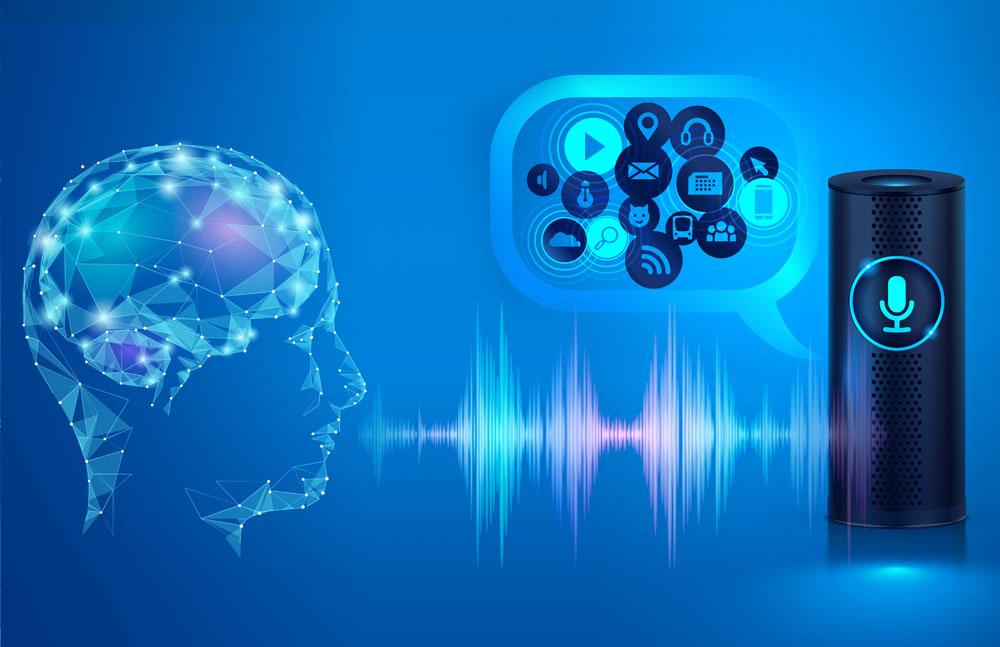What is Speech Recognition Technology?
Voice assistants and other speech recognition technologies continue to provide more personal experiences and improve the distinction between sounds.
Speech recognition technology allows hands-free control of smartphones, speakers, and even vehicles in different languages. This is a development that has been our dream for decades and has been worked on to make our lives easier and safer.
History of speech Recognition technology
Speech recognition is valuable because it saves time and money for consumers and companies.
The average typing speed on a desktop computer is about 40 words per minute. This rate decreases slightly when typing on smartphones and mobile devices.
However, we can collect between 125 and 150 words per minute regarding speech. This is a sharp increase. Thus, speech recognition helps us get things done faster – whether creating a document or talking to an automated customer service representative.
The nature of speech recognition technology is natural language to initiate an action. Modern speech technology began in the 1950s and has grown over the decades.
- The 1950s: Bell Labs develops Audrey, a system capable of detecting numbers 1 to 9 that speak with one voice.
- In the 1960s: IBM developed a shoebox device that could recognize and distinguish 16 spoken English words.
- The 1970s: It leads to Carnegie Mellon’s Harpy system, which can handle more than 1,000 words.
- The 1990s: The advent of personal computing brings faster processors and opens the door to dictation technology. Bell was dialed again with interactive voice recognition systems.
- The 2000s: Speech recognition reaches 80% accuracy, and then Google Voice enters the scene, making the technology available to millions of users and allowing Google to collect valuable data.
- 2010: Apple launches Siri, and Amazon launches with Alexa to compete with Google. These three big ones are still in charge.
Today’s leading speech recognition systems – Google Assistant, Amazon Alexa, and Apple Siri – without the early pioneers who paved the way, they will not be where they are today.
Thanks to the integration of new technologies such as cloud-based processing and continuous improvement thanks to the collection of speech data, these speech systems have continuously improved their ability to “hear” and understand a wider variety of words, languages, and accents.
How does voice recognition work?
Now that we are surrounded by smart cars, smart home appliances, and voice assistants, it is easy to see how speech recognition technology works.
Why?
Because the simplicity of talking to digital assistants is misleading, Voice recognition is complex even now.
Think about how children learn the language. From day one, they hear the words used around them. Parents talk, and their children listen. The child absorbs a variety of verbal cues: tone, inflection, syntax, and pronunciation. Their brains are tasked with recognizing complex patterns and communications based on how parents use language.
But while the human brain is hard-wired to get speech, speech recognition developers have to make the hard wires themselves.
The challenge is to create a language learning mechanism. However, there are thousands of languages, dialects, and dialects to consider. This does not mean that we are not making progress. By early 2020, Google researchers could finally outperform human performance in a wide range of language comprehension tasks.
Google’s updated model now works by tagging sentences and finding the right answer to a better human question.
The basic steps for how speech recognition technology works are as follows:
A microphone transmits the vibrations of a person’s voice to a wave-like electrical signal. This signal, in turn, is converted to a digital signal by system hardware – for example, a computer sound card.
Speech recognition software analyzes digital signals to record phonemes, units of sound that distinguish one word from another in a particular language. Phenomena are reconstructed in the form of words. To choose the right word, the program must rely on contextual symbols, which is done through trigram analysis.
This method relies on a database of recurring three-word clusters in which probabilities are assigned, followed by both words with a specific third word.
Think predictive text on your phone keyboard. A simple example would be typing “How are” and your phone “you?” Suggests. However, the more you use it, the more it recognizes your desires and suggests commonly used phrases.
Speech recognition software analyzes the recorded sound of speech into individual sounds, analyzes each sound, uses algorithms to find the most likely appropriate word in that language, and transcribes those sounds into text.
How do companies develop speech Recognition technology?
Much of this depends on what you are trying to achieve and how much you are willing to invest.
There is no need to start from scratch in coding and obtaining speech data because many of these fields are provided and can be built on.
For example, you can tap business application programming interfaces (APIs) and access their speech recognition algorithms. But the problem is that they are not adjustable.
Instead, you may need to look for voice data collection that can be quickly and efficiently accessed through an easy-to-use API, such as:
- Speech to text API from Google Cloud
- Automatic Speech Recognition (ASR) from Nuance
- Speech API to IBM Watson Text
From there, you design and develop software to suit your needs. For example, you can code algorithms and modules using Python.
Regional accents and speech disorders can disrupt word recognition platforms, and background noise can be difficult to penetrate, not to mention polyphonic input. In other words, speech comprehension is a much bigger challenge than simply recognizing sounds.
Here are the different models used to build a speech recognition system:
- Acoustic: Take the speech waveform and divide it into small pieces to predict the most likely phonemes in speech.
- Pronunciation: Take the sounds and tie them together to make words, connecting the words with their phonetic representation.
- Language: Take the words and tie them together to make a sentence, that is, predict the most likely sequence of words (or text strings) among several sets of text strings.
Algorithms can also combine the predictions of acoustic and language models so that the outputs provide the most probable text string for the input of a given speech file.
To further highlight this challenge, speech recognition systems must be able to distinguish between homophones (words with the same pronunciation but different meanings) to learn the difference between specific letters and separate words. However, the accuracy of speech recognition is what determines whether voice assistants become an accessory.
How voice assistants bring speech recognition into everyday life
Speech recognition technology has grown dramatically in the early 21st century and has returned home.
Let’s look at some of the leading options.

Siri Apple
Apple Siri emerged as the first popular voice assistant after the first popular voice assistant in 2011. Since then, the assistant has been integrated into all iPhones, iPads, Apple Watch, HomePod, Mac, and Apple TV.
Siri is even used as a key user interface in Apple’s CarPlay infotainment system and wireless AirPad and HomePod Mini headphones. Siri is with you wherever you go. On the road, at home, and for some, literally on their bodies. This gave Apple a huge advantage in terms of early acceptance.
Naturally, being the fastest often means getting more advertising advantage for a performance that may not work as well as expected.
Although Apple had a great start with Siri, many users complained about its apparent inability to understand and interpret voice commands properly. If you ask Siri to text or call you, it can easily do so. However, when interacting with third-party applications, Siri was a little stronger than its competitors.
But today, an iPhone user can say, “Hey Siri, I want to go to the airport” or “Hey Siri, order me a car,” and Siri will open any app you have on your phone and book your trip.
Focusing on the system’s ability to handle subsequent questions, translate language, and change Siri’s voice to something human-like helps improve the voice assistant user experience. Since 2021, Apple has been floating above its competitors in terms of availability by country and thus understanding a range of foreign accents. Siri is available in over 30 countries and 21 languages - and in some cases, in several different dialects.
Amazon-Alexa
In 2014, Amazon introduced the Alexa and Echo to the world, ushering in the era of smart speakers.
Alexa is now inside the Echo, the Echo Show (a tablet with voice control), the Echo Spot (an alarm clock with voice control), and the Echo Buds (Apple AirPods version of Amazon) headphones.
Unlike Apple, Amazon has always believed that the most “skilled” voice assistant (the term for audio applications on echo assistant devices) “even if it sometimes makes a mistake and tries harder to use it, fans” “Loyal will win.”
Although some users see the word Alexa as a shadow behind other audio platforms, the good news is that Alexa adapts to your voice over time and fixes problems it may have with your particular accent or accent.
In terms of skills, the Amazon Alexa Skills Kit (ASK) may be what has made Alexa such a viable platform. ASK allows third-party developers to build applications and take advantage of Alexa power without the need for native support. Alexa was ahead by integrating smart home devices such as cameras, door locks, entertainment systems, lighting, and thermostats.
Google Assistant
How many of us have said or heard “let me Google it for you”? It looks like almost everyone. In this case, it makes sense that Google Assistant would be the answer to (and understand) all the questions that its users may have.
From requesting a phrase translation into another language to others, Google Assistant responds correctly, provides additional context, and cites a source website for information.
Given that Google’s powerful search technology supports it, this may be a surprising warning.
Although Amazon Alexa (via Echo) was released two years earlier than Google Home, Google has come a long way in reaching Alexa in a very short time. Google Home was released in late 2016 and, within a year, introduced itself as Alexa’s most important competitor.
In 2017, Google had 95% word accuracy for US English, the highest of all voice assistants currently available. This translates to a word error rate of 4.9% – which puts Google first in the 5% threshold.
However, the word error rate has its limitations. Data are affected by factors such as:
- Background sound
- Reciprocal discussion
- Accents
- Rare words
- Written text
However, they are close to 0%, and this is significant.
Where else is speech recognition technology common?
Voice assistants are the only mechanisms through which advances in speech recognition are becoming mainstream. Here is just one important point.
In-car speech recognition
Voice activators and digital voice assistants are not just to make things easier. They also apply to safety – at least when it comes to car speech recognition.
Companies like Apple, Google, and Nuance have completely changed the driver experience in their vehicle – to eliminate the distraction of looking at a cell phone while driving, allow drivers to keep their eyes on the road.
Instead of texting while driving, you can now tell your car who to call or which restaurant to go to. Instead of scrolling through Apple Music to find your favorite playlist, you can ask Siri to find it and play it.











